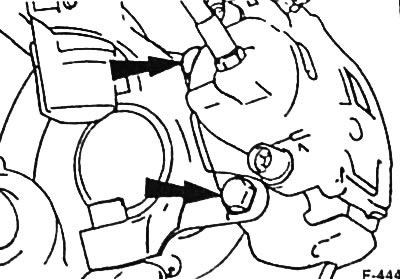Attention: For vehicles with a TEVES MK II brake system, pressurize it before opening it. To do this, turn the ignition key to position 0 and press the brake pedal until (at least 20 times), until the resistance to pressing the pedal increases greatly.
Withdrawal
Mark the position of the wheel on the hub with paint. Thanks to this, the balanced wheel can be installed again in its original position.
When loosening the wheel nuts, the vehicle must be on its wheels.
Raise the front of the car on the stand goats.
Remove wheel.
Remove brake pads see p. 112.
If the piston housing does not need to be removed, it should be hung on a wire to the spring so that the brake hose is not twisted or stretched.
If the piston housing needs to be removed, the brake hose must be unscrewed from it.
Warning: Brake fluid will leak out. Collect brake fluid in a bottle designed exclusively for brake fluid. After assembly, air must be bled from the brake system.

Unscrew the 2 mounting bolts and remove the brake shoe guide from the swivel bearing.
Installation
If the piston housing was removed, screw on the brake hose. Fit a new seal, tighten the connecting bolt to 35 Nm.
Attach the brake shoe guide and tighten both bolts on the swivel bearing to 60 Nm.
Attention: The brake hose must not be twisted during installation.
Install brake pads, see p. 112.
If the brake system has been opened, remove air from the brake system, see p. 117.
Attach the front wheels so that the marks made before removal coincide. Tighten the wheels with nuts. Lower the vehicle and tighten the wheel nuts crosswise to 100 Nm.
Caution: Depress the brake pedal strongly repeatedly with the vehicle stationary until strong resistance is felt.
Check the brake fluid level in the expansion tank and, if necessary, top up the tank to the MAX mark.
Turn the steering wheel in both directions until it stops and make sure that the brake hoses do not rub anywhere and are not pinched.
Visitor comments